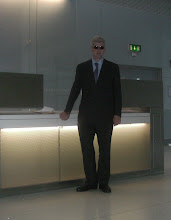The HV outputs of the spark coils are connected to a rectifier (D1) made from four HV diodes potted in epoxy resin. Connected to this is a small smoothing capacitor (C1) which helps to reduce the ripple in the HV DC output. The tank capacitor (C2) is charged from the HV DC supply via two RF chokes (inductors L1 & L2) which serve to prevent the RF oscillations of the TC primary circuit from interfering with the rest of the circuit.The previous battery powered Tesla coil design needed to be well connected to a good RF ground such as a metal rod in the earth. Without this the output would be limited and the driver circuit would be prone to failure.

With this mini Tesla coil the RF ground connection is made by connecting it to a copper pad on the handle.The body of the person holding the device is used as the RF ground and the large area of copper ensures the energy is spread out to prevent RF burns.In most Tesla Coils this would not be safe at all but this device is very low power so there is little risk of electric shock. The RF its self probably isn't too healthy though!The TC part (Tesla Coil) uses the common single static spark gap and flat primary design for simplicity and size. The primary coil is closely wound around the base of the secondary with several layers of insulation tape preventing flash over. Can be used in mock games to allow a friend sizzle a little an experience of tingle as this electrical current flows true air.
 From Wise labs designs this ray gun that can stop people in their tracks without harming them may sound like science fiction, but some experts believe it could soon be reality. The ray charge is designed to zap its victim with an electric current, using a laser to carry the charge along a beam of ultraviolet light. The light particles, called photons, would create a path through the air that will be capable of conducting electricity up to a distance of about 100 metres (330 feet). When the current hits someone, it would interfere with the tiny electrical charges that control the victim's muscles, making movement impossible. Vital organs are protected and vital organs like the heart and diaphragm would not be affected because they are protected by a greater thickness of body tissue. It Perfectly safe tho it can pack a little sizzle also new propulsion idea with Electra magnetic charge it takes a few seconds to recharge.
From Wise labs designs this ray gun that can stop people in their tracks without harming them may sound like science fiction, but some experts believe it could soon be reality. The ray charge is designed to zap its victim with an electric current, using a laser to carry the charge along a beam of ultraviolet light. The light particles, called photons, would create a path through the air that will be capable of conducting electricity up to a distance of about 100 metres (330 feet). When the current hits someone, it would interfere with the tiny electrical charges that control the victim's muscles, making movement impossible. Vital organs are protected and vital organs like the heart and diaphragm would not be affected because they are protected by a greater thickness of body tissue. It Perfectly safe tho it can pack a little sizzle also new propulsion idea with Electra magnetic charge it takes a few seconds to recharge. Wise labs also tested other mediums like steam and plasma charged projectile these seem to be more effective as the plasma Carry's a electrical current inside sticking to host and releasing a full discharge called the spider web silica easy refillable substance where one might need its formulation(C) here it is making aerogels from carbon nano tubes. The researchers at wise labs were able to succeed where so many before them had failed using a wet gel of well-dispersed pristine MWCNTs. After removing the liquid component from the MWCNT wet gel, they were able to create the lightest ever free-standing MWCNT aero gel monolith with a density of 4 mg/cm3. MWCNT aero gels infused with a plastic material are flexible, like a spring that can be stretched thousands of times, and if the nano tubes in a one-ounce cube were unraveled and placed side-to-side and end-to-end, they would carpet three football fields. The MWCNT aerogels are also excellent conductors of electricity, which is what makes them ideal for sensing applications and offers great potential for their use in electronics components there also near invisible a new fashion fabric well you heard it first at Wise Labs.
Wise labs also tested other mediums like steam and plasma charged projectile these seem to be more effective as the plasma Carry's a electrical current inside sticking to host and releasing a full discharge called the spider web silica easy refillable substance where one might need its formulation(C) here it is making aerogels from carbon nano tubes. The researchers at wise labs were able to succeed where so many before them had failed using a wet gel of well-dispersed pristine MWCNTs. After removing the liquid component from the MWCNT wet gel, they were able to create the lightest ever free-standing MWCNT aero gel monolith with a density of 4 mg/cm3. MWCNT aero gels infused with a plastic material are flexible, like a spring that can be stretched thousands of times, and if the nano tubes in a one-ounce cube were unraveled and placed side-to-side and end-to-end, they would carpet three football fields. The MWCNT aerogels are also excellent conductors of electricity, which is what makes them ideal for sensing applications and offers great potential for their use in electronics components there also near invisible a new fashion fabric well you heard it first at Wise Labs.



No comments:
Post a Comment